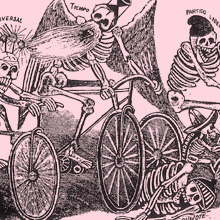
Hay morir riendo, reír de morir y morir por reír. Este último es el más infame, ya que es un ataque a la libertad de pensamiento, una violación de la Humanidad. La primera es, sin duda, la mejor manera de iniciar “el camino” (como dicen los mayas), mientras que la segunda es un ritual de liberación para quienes se quedan aquí.
Una de las culturas que experimenta esta relación tan especial entre la comedia y la muerte es la mexicana, con especial énfasis en el culto al «Día de Muertos». Un artista importante en la creación de la iconografía que aún hoy existe, fue el litógrafo José Guadalupe Posada (Aguascalientes 2/2/1852 – Ciudad de México 20/1/1913) quien en sus sátiras utilizó y abusó del uso de esqueletos y calaveras (gráfica tradición que ya aparecía esporádicamente desde 1825 en la prensa mexicana), siendo la más conocida y reproducida en el marketing actual la «Calavera Catrina».
En realidad, esta tradición de “jugar” con la muerte, de utilizar la comedia en el duelo, es mucho más antigua y tiene adeptos en distintas partes del planeta. Por ejemplo, en el África subsahariana, hay tribus que, para apoyar al difunto en ese momento de soledad y desorientación, crean entretenimiento, desarrollando actitudes burlescas en el funeral, emborrachándose, comiendo orgías, contando chistes… En el África norteña En la ciudad de Nueva Orleans una comunidad descendiente de esclavos africanos desarrolló “funerales de jazz”, donde se toca música triste y cómica, se baila, hay un desfile casi de carnaval…
En México, los “conquistadores” españoles, al imponer sus tradiciones cristianas, no hicieron más que obligar al pueblo mesoamericano a adaptar sus creencias y rituales, bajo nuevas formas, a las nuevas fechas del calendario. El «Día del Recuerdo», o Día de Muertos, ya existía en su cultura y se celebraba a mediados de agosto del calendario gregoriano, pasando ahora a principios de noviembre –el «Hanal Pixan» que termina después de ocho días con el «Bix» - 1 al 8 de noviembre.
México es un vasto territorio con varios pueblos/civilizaciones como los purépechas, totonacas, rarámuri, zapotecas (del 22 al 31 de octubre - Xanduu’yaa)… los mayas, los méxica (también conocidos como aztecas). Para ellos no hay angustia ante la muerte, ya que es con la muerte (y con la sangre) que se alimenta el Cosmos y se asegura la fertilidad del futuro. La muerte es inevitable, es vuestra compañera y cómplice de cada día, y podéis y debéis intercambiar chistes, burlaros de ella, enviarle chistes y hacerle regalos. En realidad, no existe la muerte como final, solo un paso, para continuar el camino de la existencia, que puede seguir siendo olvidada o amada por la memoria de quienes aquí quedan (la película “Coco” resume muy bien esta filosofía). Mientras seamos recordados, seguiremos vivos, no sólo allí, sino aquí. Aquí, además de los buenos recuerdos, también puedes celebrar con los buenos placeres de la mesa, ya sea en picnics junto a la tumba en el cementerio, o en los altares caseros con los platos favoritos del difunto, o con Mole, Tamales, pan de los muertos, Atole, Jicamas, Jicarastan-chucuá… las «Calaveras» (alfeñique de azúcar o Tzoall de chocolate), regadas con Tequilha, Balché… un vaso de agua para calmar la sed del difunto y Thaloc y Chaac (dioses de la lluvia)…
En esta celebración con muchas risas y música también se encuentran las «Calaveras Literarias» que son pequeños poemas (de hasta 12 versos como máximo) biográficos, cómicos y satíricos, referidos al difunto o intercambiados entre familiares para, a través de la risa, limpiar relaciones negativas. y con risas consolidar las complicidades familiares. En ocasiones, estas «Calaveras» también se publican en la prensa local, o en «prospectos». En este caso son anónimos, casi como la “voz del pueblo” para satirizar ciertos comportamientos de personajes destacados de la localidad.
Como escribió el poeta Jaime Sabines, “morir es estar en todas partes”, es experimentar los estados de ánimo de la vida y el renacimiento, porque la sociedad que tiene presente en paz la muerte, venera la vida.
Del pasado al presente, mucho ha cambiado en México, y fueron esencialmente los mestizos quienes terminaron dando fuerza a los medios de intervención crítica, al encontrarse en ese limbo de no aceptación por parte de los verdaderos nativos y los amos colonizadores. Es un territorio vasto, con múltiples culturas ancestrales, por lo que es natural que uno de los artistas más antiguos y reconocidos de la actualidad - Rruitze (Ruiz Tejada Rafael) termine diciendo «De las diversas culturas mexicanas, que son muchas, hay No hay grandes datos sobre las tradiciones autóctonas vinculadas al humor. Lo que hay son interpretaciones de arqueólogos y antropólogos».
¿Pero se puede decir que hay un humor mexicano especial? «El humor mexicano es bastante idéntico al de otros países. Tiene un toque de descaro muy especial. Eso es lo que es diferente…”
En otras palabras, es lo mismo pero un poco diferente…. Ya hemos hablado de la forma en que enfrentan la muerte y la vida, pero para los mexicanos esto no es una cuestión de estados de ánimo, sólo existencial. Entonces, ¿en qué género artístico se manifiesta mejor el humor mexicano? «El humor mexicano se manifiesta especialmente en la caricatura. Ha sobrevivido a lo largo de los años con muchas dificultades pero con mucha perseverancia. Ha sido censurada, perseguida, boicoteada por motivos políticos, económicos… y ahora mismo la excusa es la pandemia. En México, la caricatura se ha resentido por la pandemia del virus. Muchos periódicos han despedido a sus caricaturistas (yo soy uno de ellos, el mes que viene se cumplirá un año desde que publiqué en algún lugar). Los dueños de las revistas son ladrones, y lo que ofrecen a los caricaturistas, por su trabajo, es miseria».
De todas formas, México es una potência de humores e incluso cuenta con un Museo de la Caricatura instalado en una de las estaciones del Metro de la Ciudad de México (Zapata), así como… «En la Ciudad de México tenemos dos Museos. El mejor se llama “El Estanquillo”, fundado por un escritor humorista y crítico de gobiernos. También está la Sociedad Mexicana de Caricaturistas. Se encuentra en un edificio del siglo XVI, que está a punto de caerse y derrumbarse. Es un edificio del Gobierno de la Ciudad de México y sobrevive de milagro, allí no se puede hacer nada. En la estación “Zapata” se realizan exposiciones esporádicas como alternativa y como forma de estar más cerca del público».
¿Y cómo se ve Rruitze siendo, creo, el caricaturista más viejo de México? «Son más de 80 viajes al sol. No sé si soy el mayor.
Llegar a viejo tiene su chiste. Tal vez para dibujar, pintar, escribir o leer los ojos ya no son los mismos. Al ir a un museo y los vigilantes nos sacan a jalones a la calle por tocar con la punta de la nariz alguno de los cuadros ahí exhibidos, significa que nuestros ojos ya están cansados. Cuando las manos tiemblan, como de músico maraquero, es otra señal de que ya le hemos dado más de 80 años al sol. Si por la calle vemos que todos llevan su celular y con él platican y miran al interlocutor que está en otro continente y nos parece película de ficción, son las diferencias de el lejano ayer y el hoy del presente. Todas las actitudes y actividades modernas invitan a tomarlo con HUMOR y a dibujarlo todo. La memoria también se oxida con el tiempo. Podremos recordar una escena chusca que nos ocurrió en la escuela cuando teníamos 12 años pero olvidamos tomar una medicina que deberíamos tomar tres horas antes. Las neuronas van muriendo al paso del tiempo y nos hace caer en la “Demencia senil”.
Al pasar al gremio de los ancianos, podemos perder las llaves de casa, los anteojos, el automóvil, etcétera y lo que no debemos perder es el HUMOR. Envejecer es divertido. No es fácil. No cualquiera puede lograr esa hazaña. Para quienes hacemos o vivimos haciendo HUMOR, deberíamos terminar nuestro ciclo de vida con la tranquilidad que nos da ese magnífico don. Para quien ya consumismo gran parte de los años, entramos del: ¿Cómo?; ¿Qué dijo usted?; ¿Me lo puedes repetir? El sistema auditivo, casi siempre, muere antes que el portador. Al humorista, al verdadero humorista, no le podemos aceptar que no mire o no acepte el final de la vida con algo de HUMOR. En mi caso, hace casi 20 años que hice mi urna funeraria. La hice con plastilina y la fundieron en bronce. A varios les sorprende y molesta que está llena de caricaturas, empezando con la mía sobre la tapadera de mi futura casa de 6 kilos de peso. Quisiera - y por eso me cuido - durar lo más posible para seguir viendo a mi familia y ver crecer a mis nietos y disfrutarlos. Los humanos, la mayoría, no todos viven con la ilusión de que, al morir, volverán a estar junto a familiares o amigos que murieron antes. Esto basado en las mentiras creadas por las diferentes religiones. Ahí también aparece deslumbrante el HUMOR. Ese HUMOR que muy pocos vemos.
Los humanos creamos infiernos y cielos de la ilusión y la fantasía. Terrible sorpresa se llevarían al no encontrar nada de eso. Mirar el futuro con HUMOR no es nada fácil. Carecen de HUMOR quienes se sienten dueños del planeta solo porque son gobernantes y tienen al alcance de su mano el temible Botón atómico. Nacer es natural y morir también lo es y llegar al final con HUMOR no todos lo lograremos. Pienso, con HUMOR, el futuro de mi familia planeando qué hacer con unas 70 mil caricaturas y dibujos publicados en revistas, periódicos y programas de televisión además de unas 250 pinturas al óleo, acrílico, etc. que hoy llenan todos los rincones de mi casa. Esas escenas de mis parientes abrumados por no saber dónde poner o tirar toda esa tonelada de obras y libros me llena de buen HUMOR. Tratemos de ver con mucho HUMOR el tránsito en nuestra vida y el final de ella.
Osvaldo está figura la hice para contar como el tiempo nos va consumiendo si fuéramos de cera. Nos acabamos como cirios de parafina. Así me ha dejado la vida.»
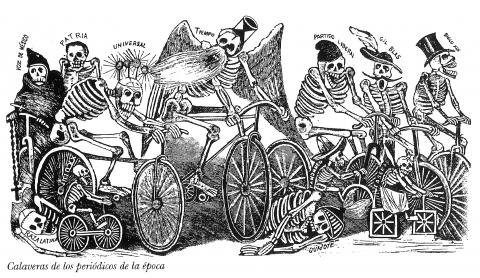
posada No. 1
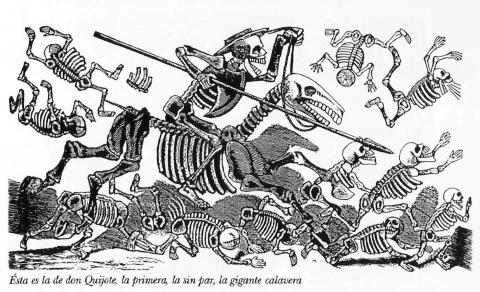
posada No. 2
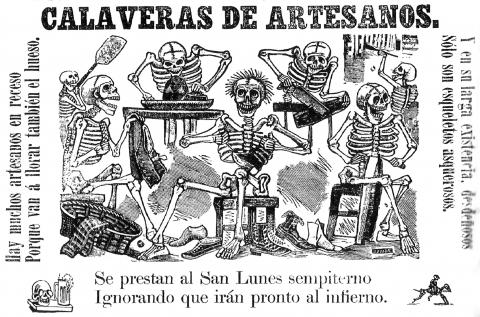
posada No. 3
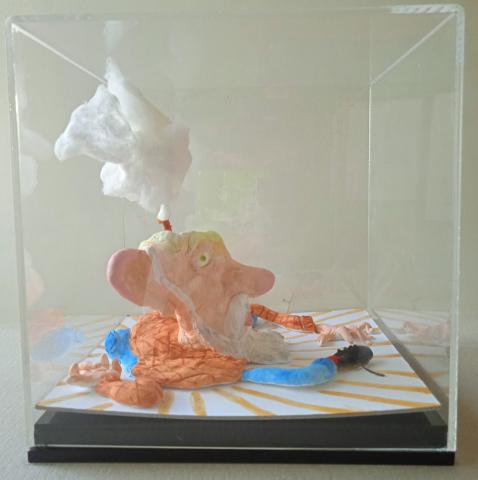
Rruitze No. 1
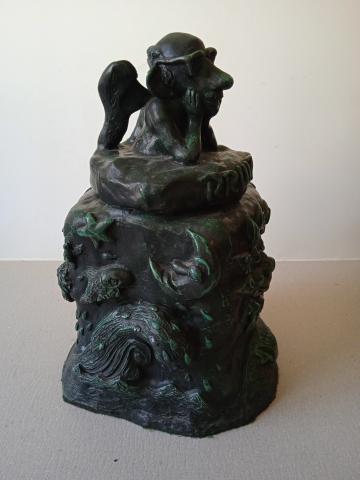
Rruitze No. 2
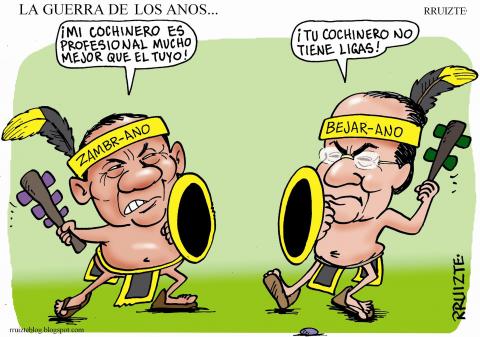
Rruitze No. 3
Humor of the World – Mexico / Rruitze (Day of the Dead)
By: Osvaldo Macedo de Sousa
There is dying laughing, laughing at dying and dying for laughing. The last is the most infamous, as it is an attack on freedom of thought, a violation of Humanity. The first is, without a doubt, the best way to start “the path” (as the Maya say), while the second is a liberation ritual for those who stay here.
One of the cultures that experiences this special relationship between comedy and death is the Mexican one, with special emphasis on the cult of the «Day of the Dead». An important artist in the creation of iconography that still exists today, was the lithographer José Guadalupe Posada (Aguascalientes 2/2/1852 – Mexico City 20/1/1913) who in his satires used and abused the use of skeletons and skulls (graphic tradition which had already appeared sporadically since 1825 in the Mexican press), the best known and most reproduced in current marketing being the «Calavera Catrina».
In reality, this tradition of “playing” with death, of using comedy in mourning is much older and has followers in different parts of the planet. For example, in sub-Saharan Africa, there are tribes that, to support the deceased in that lonely and disorienting moment, create entertainment, developing burlesque attitudes at the funeral, getting drunk, eating orgies, telling jokes... In the North American city of New Orleans the A community descended from African slaves developed “Jazz funerals”, where sad and comical music is played, there is dancing, there is an almost carnival parade…
In Mexico, the Spanish “conquistadors”, by imposing their Christian traditions, did nothing more than force the Mesoamerican people to adapt their beliefs and rituals, under new guises, with the new dates on the calendar. «The Day of Remembrance», or Day of the Dead, already existed in their culture and was celebrated in mid-August of the Gregorian calendar, now moving to the beginning of November – the «Hanal Pixan» which ends after eight days with the «Bix » - 1st to 8th November.
Mexico is a vast territory with several peoples/civilizations such as the Purépechas, Totonacas, Rarámuri, Zapotecs (from October 22nd to 31st - Xanduu’yaa)… the Mayas, the Méxica (also known as Aztecs). For them there is no anguish in the face of death, since it is with death (and blood) that the Cosmos is fed and the fertility of the future is ensured. Death is inevitable, it is your daily companion and daily accomplice, and you can, and should, exchange jokes, make fun of it, send it jokes and give it gifts. In reality, there is no death as an end, just a passage, to continue the path of existence, which can continue to be forgotten or loved by the memory of those who remain here (the film “Coco” summarizes this philosophy very well). As long as we are remembered, we remain alive, not only there, but here. Here, in addition to good memories, you can also celebrate with the good pleasures of the table, whether at picnics next to the grave in the cemetery, or at the home altars with the deceased's favorite dishes, or with Mole, Tamales, bread of the dead, Atole , Jicamas, Jicarastan-chucuá… the «Skulls» (sugar alfeñique or chocolate Tzoall), washed down with Tequilha, Balché… a glass of water to quench the thirst of the deceased and Thaloc and Chaac (rain gods)…
In this celebration with lots of laughter and music there are also «Literary Skulls» which are small poems (up to 12 verses maximum) biographical, comical and satirical, referring to the deceased or exchanged between family members to, through laughter, cleanse negative relationships and with laughter consolidate family complicities. Sometimes, these «Calaveras» are also published in the local press, or in «fly sheets». In this case, they are anonymous, almost like the “voice of the people” to satirize certain behaviors of prominent figures in the locality.
As the poet Jaime Sabines wrote, «to die is to be everywhere», it is to experience the moods of life and rebirth, because the society that keeps death in mind in peace, reveres life.
From the past to the present, much has changed in Mexico, and it was essentially the mestizos who ended up giving strength to the means of critical intervention, as they found themselves in that limbo of non-acceptance by the true natives and the colonizing masters. It is a vast territory, with multiple ancestral cultures, which is why it is natural that one of the oldest and most renowned artists of our time - Rruitze (Ruiz Tejada Rafael) ends up saying «Of the various Mexican cultures, which are many, there is no great data on the native traditions linked to humor. What there are are interpretations by archaeologists and anthropologists».
But can it be said that there is a special Mexican humor? «Mexican humor is quite identical to that of other countries. It has a very special touch of sassiness. That’s what’s different…»
In other words, it’s the same but a little different…. We have already talked about the way they face death and life, but for Mexicans this is not a question of moods, just existential. So in what artistic genre does Mexican humor best manifest itself? «Mexican humor manifests itself especially in caricature. It has survived over the years with many difficulties but with a lot of perseverance. It has been censored, persecuted, boycotted for political and economic reasons... and right now the excuse is the pandemic. In Mexico, caricature has suffered due to the virus pandemic. Many periodicals have laid off their cartoonists (I'm one of them, next month it will be a year since I published anywhere). The owners of the periodicals are thieves, and what they offer to cartoonists, for their work, is misery».
In any case, Mexico is a powerhouse of moods and even has a Caricature Museum installed in one of the Metro stations in Mexico City (Zapata), as well as… «In Mexico City we have two Museums. The best one is called “El Estanquillo”, having been founded by a humorist writer and critic of governments. There is also the Sociedad Mexicana de Caricaturistas. It is housed in a 16th century building, which is on the verge of falling and collapsing. It's a Mexico City Government building and it survives by miracle, nothing can be done there. At the "Zapata" station, sporadic exhibitions are held as an alternative and as a way of being closer to the public».
And how does Rruitze see himself as being, I believe, the oldest cartoonist in Mexico?
«There are more than 89 trips to the sun. I don't know if I'm the oldest.
Getting old has its joke. Maybe your eyes are no longer the same when it comes to drawing, painting, writing or reading. When we go to a museum and the guards drag us out into the street for touching one of the paintings exhibited there with the tip of our nose, it means that our eyes are already tired. When the hands shake, like a maraquero musician, it is another sign that we have already given more than 80 years to the sun. If on the street we see that everyone carries their cell phone and with it they talk and look at the interlocutor who is on another continent and it seems like a fiction movie to us, those are the differences between the distant yesterday and the present today. All modern attitudes and activities invite you to take it with HUMOR and draw everything. Memory also rusts over time. We can remember a funny scene that happened to us at school when we were 12 years old but we forgot to take a medicine that we should have taken three hours before. Neurons die over time and cause us to fall into “Senile Dementia”.
When we join the guild of the elderly, we can lose our house keys, our glasses, our car, etc., and what we should not lose is HUMOR. Getting older is fun. Is not easy. Not everyone can achieve that feat. For those of us who do or live doing HUMOR, we should end our life cycle with the peace of mind that this magnificent gift gives us. For those who have been consumerists for most of the years, we enter from: How?; You said?; Can you repeat it? The auditory system almost always dies before the wearer. We cannot accept the comedian, the true comedian, who does not look at or accept the end of life with some HUMOR. In my case, it has been almost 20 years since I made my funeral urn. I made it with plasticine and they cast it in bronze. It surprises and bothers many people that it is full of caricatures, starting with mine on the cover of my future house weighing 6 kilos. I would like - and that is why I take care of myself - to last as long as possible to continue seeing my family and seeing my grandchildren grow up and enjoy them. Humans, most, not all, live with the illusion that, when they die, they will be reunited with family members or friends who died before. This based on the lies created by different religions. HUMOR also appears dazzling there. That HUMOR that very few of us see.
Humans create hells and heavens of illusion and fantasy. They would be terribly surprised not to find anything like that. Looking at the future with HUMOR is not easy at all. Those who feel like owners of the planet just because they are rulers and have the fearsome Atomic Button at their fingertips lack HUMOR. Being born is natural and dying is also natural and reaching the end with HUMOR, not all of us will achieve it. I think, with HUMOR, about the future of my family, planning what to do with some 70 thousand caricatures and drawings published in magazines, newspapers and television programs in addition to some 250 oil, acrylic paintings, etc. that today fill every corner of my house. Those scenes of my relatives overwhelmed by not knowing where to put or throw away all that ton of works and books fills me with good MOOD. Let's try to see the transition in our life and the end of it with a lot of HUMOR.
Osvaldo I made this figure to tell how time consumes us if we were made of wax. We ran out like paraffin candles.
"This is how life has left me.»
